
What is an ATS?
Most companies today use some form of HR technology or candidate management system to help with their hiring and recruitment efforts. These systems are commonly known as applicant tracking systems or ATS for short.
In our article “What is an applicant tracking system?”, we explain that an ATS has various functions. In brief, applicant tracking systems help companies streamline their hiring processes, by automating manual tasks and improving collaboration across teams and between hiring managers.
From initial submissions to final candidate selections, an ATS can automate the entire process of handling job applications, resulting in a significant reduction in manual work. In other words, applicant tracking systems make it easier for companies to manage large volumes of applications, allowing hiring teams to evaluate applications objectively and in a more organized manner.
Applicant tracking systems also help recruiters quickly identify qualified candidates by parsing resumes. They also facilitate collaboration and communication among hiring team members. Additionally, applicant tracking systems help standardize processes which reinforces compliance with hiring regulations.

Benefits of an applicant tracking system
The main reasons companies use an ATS are simple – to save time, save money, and provide candidates with a positive and engaging experience. From startups and SMBs to enterprises and multinationals, applicant tracking systems provide great solutions for companies of all sizes.
Applicant tracking systems can significantly enhance organizational efficiency by automating resume screening, reducing manual work, and speeding up hiring. They can also streamline collaboration between hiring teams, resulting in a more efficient recruitment process. This efficiency, in turn, leads to a better candidate experience since timely responses and personalized interactions make a positive impression on candidates.
Last but not least, besides providing a better candidate experience and helping companies improve their recruitment processes, an ATS ensures regulatory compliance with hiring regulations, minimizing the risk of legal issues.
94% of recruiters and hiring professionals say their ATS or recruiting software has positively impacted their hiring process.
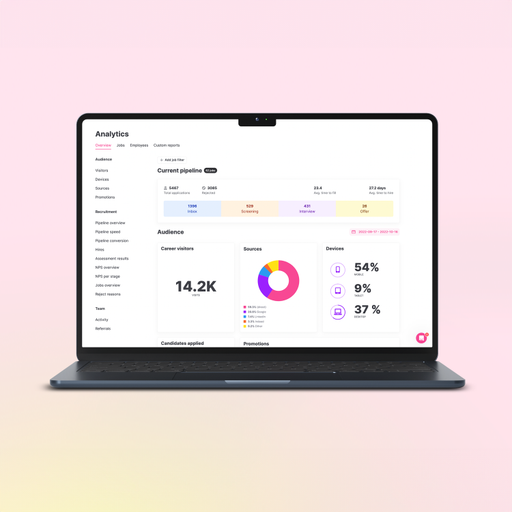
How applicant tracking systems work
Applicant tracking systems offer a range of functionalities to optimize the hiring process. First, they can automate job ads, post them on various job sites, and then track the influx of applications. Resumes are then analyzed and organized, allowing recruiters to easily search and filter applicants to identify the right candidates and reduce your company's cost.
Secondly, with the collaborative features available, members of the hiring team can communicate and align with one another throughout the entire process. The software's automation tools help streamline processes through every stage of recruitment, from initial application to interviews and, ultimately, the hiring decision.
The reporting and analytics tools available offer users insights into recruitment metrics, enabling HR to adapt, fine-tune, and optimize its ways of working. To see how you can use analytics to reduce time-to-hire, be sure to read our article on recruitment analytics.
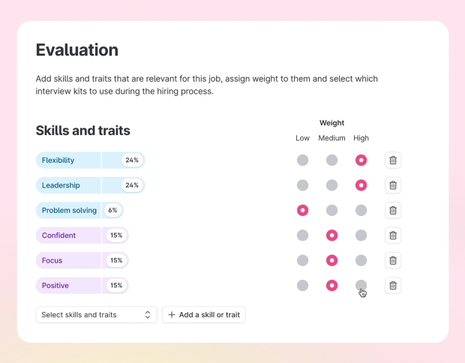
How can an ATS help evaluate candidates?
Recruitment is a complex process. The challenge is to find the right person for the job among the many talented candidates in the pipeline. One company that understands this well is SATS – the biggest fitness chain in the Nordics. Founded in 1995 in Norway, today SATS has over 275 clubs and 10,000 employees throughout the Nordics.
Today, all SATS managers use their ATS with various degrees of collaboration depending on the role they’re seeking to fill. Using their ATS to evaluate candidates, the team uses a feature called Job Match Score, which provides a better understanding of which candidates match the desired skills and traits. To learn more about how an ATS can facilitate the evaluation of candidates, read our article about how to evaluate candidates to find the right hire.
Johan Westberg, Nordic Culture and People Manager at SATS, says that one of the reasons they chose their ATS provider Teamtailor was based on its innovative and smart features, such as automated triggers and anonymous hiring, as well as access to data and analytics. To learn more about the benefits of anonymous hiring, we recommend reading the article, Removing Bias from the Recruitment Process.
“Our ATS has helped us a lot with our daily operations. Everything runs smoothly, and seamlessly, and is safe and secure as well. The whole back office administration has become so much easier. There has been a significant reduction in time.” – Johan Westberg, Nordic Culture and People Manager at SATS

Applicant tracking systems from a candidate perspective
According to findings, 60% of applicants quit an application because they say it was too complex or too long. What's more, 70% of applicants feel an online application should be five steps or fewer, only 40% of employers think the same.
The fact is that applicant tracking systems not only make life easier for recruiters and hiring managers, they also enhance the candidate experience. And in more ways than one.
First and foremost, with an ATS, applying for a job couldn't be easier. In many cases, candidates can simply upload their CVs, cover letters, and portfolios without the need to log in or create an account. Instead, they can connect their LinkedIn profiles. After just a few clicks – voila! They've submitted their application.
Today, it's essential that applicant tracking systems are mobile-friendly, so they can accommodate the preferences of modern applicants. A mobile-friendly job application can reach a wider audience since not every candidate has full-time computer access, including labor workers and retail workers. In fact, one study shows that making job applications mobile-friendly increases applicants by more than 11%.

How an ATS can enhance candidate experience
For hiring teams, automation features like resume parsing (that is, the organization and analysis of resumes) not only expedite the candidate screening process but also allow time to provide more personalized feedback, which, of course, contributes to a more positive candidate experience. The ability for candidates to book their own interviews and receive automated email updates about their applications also enhance the candidate experience.
In addition to optimizing employers' recruitment workflow, applicant tracking systems have the ability to create a positive, transparent, and candidate-centric experience, resulting in a positive experience even if they're not chosen, which, in turn, boosts the employer brand.
To learn more, don't miss our article "Why Does Candidate Experience Matter?", where Lisa Skinner Källström (CPO at Teamtailor), Alex Tidgård (Psychologist and co-founder of Asker), Simon Werner-Zankl (CEO and founder of Trustcruit) and Leonam Espindola (People and Growth at Oneflow) discuss why a positive candidate experience is so important.
What to look for in an applicant tracking system
When selecting an applicant tracking system, it's important to consider whether the key features align with your company's needs. While there are many applicant tracking systems on the market, recruiters and users agree that it's important to choose one that is:
Easy-to-use and implement
The whole point of an ATS is that it helps you reduce manual work and optimize your recruitment. Therefore, any learning curve should be minimal. The interface should be easy to use and intuitive. With the right ATS, you should be able to onboard hiring managers with minimal training and start using your software right away thanks to an easy implementation and integration with other systems.
Designed to increase collaboration
An ATS should enable you to work closer and more efficiently across teams through the automation of daily tasks. Collaboration tools are critical for enhancing teamwork among hiring team members. Features like collaborative feedback, shared candidate notes, and user roles and permissions contribute to a more transparent and efficient hiring process.
Tailorable to your needs
An ATS should work for you, not the other way around. Therefore, it should be customizable to your preferred ways of working. Users should be able to tailor workflows, fields, and reporting functionalities to match their recruitment processes. The flexibility of the ATS ensures that it adapts to the organization's specific needs as they change over time.
Personalized with real customer support
While some things can be outsourced or made simpler with AI, customer support is one area that should not. Whenever you need assistance, your ATS provider should be accessible via chat, phone, or e-mail. Additionally, it's important that the help you receive is personalized and provided by a real person. Customer service that is provided by a real person is crucial to building trust and providing a personalized experience.
Candidate-focused
Candidate experience is directly impacted by an ATS. A user-friendly and intuitive applicant tracking system ensures smooth application processes, timely updates, and transparent communication. Candidates shouldn’t have to jump through fire hoops to make an application. Log-in and account creation requirements are likely to deter candidates from applying. The application process should be fun and bring the candidate closer to the company.
Scalable
Your ATS should be able to grow with your company and recruitment needs without compromising performance. Does your ATS offer unlimited users or are restricted to a certain number? In addition to ensuring efficiency, cost-effectiveness, and optimal performance throughout your evolving hiring processes, a scalable ATS can handle a handful of hires or scale to meet high-volume recruitment needs.
Mobile compatible
In today's dynamic work environment and to satisfy the needs of candidates, mobile compatibility is essential. Mobile-friendly ATSs or dedicated mobile apps provide recruiters with flexibility and responsiveness while managing the hiring process on the go.
Offers analytics to improve your hiring
The ability to analyze and report data enables data-driven decisions. A robust ATS should allow for the creation of reports on key metrics such as time-to-fill, source effectiveness, and candidate pipeline status. With analytics, companies can continuously refine and optimize their recruitment strategies.
Secure and compliant
Choosing an ATS that adheres to data protection regulations and processes all personal data in compliance with applicable laws is crucial. Adhering to regulations ensures the safeguarding of sensitive candidate information, mitigates legal risks, and builds trust.
Data Import
Moving from one system to another often requires transferring candidate information from the old system to the new one. Applicant tracking systems should make it easy for users to import this data and without any lengthy delays.
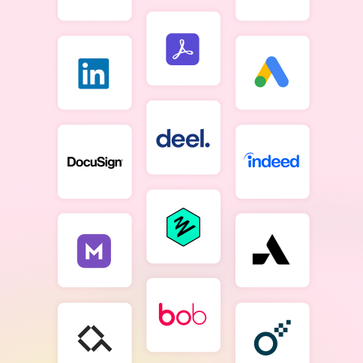
What to consider when implementing an ATS
The ease of implementation is a critical factor when choosing an applicant tracking system. Implementation directly impacts how quickly a company can reap the rewards of the system. Implementation that is smooth ensures minimal disruption to recruitment activities and results in a faster return on investment.
Leading applicant tracking systems can seamlessly integrate with other HR systems, including payroll to create a more holistic HR function. To learn more about the power of integrations, read our article which explores how UK-based events staffing recruitment agency Xenia Recruitment integrated its ATS with a workforce management system (WSM) to maximum effect.
Selecting an ATS with a user-friendly interface and intuitive setup is extremely important. By reducing the learning curve, administrators and recruiters can navigate the system more efficiently.
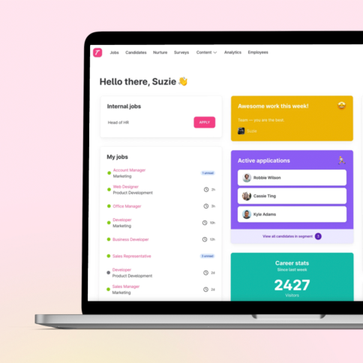
How to implement an applicant tracking system
Effective implementation of an ATS requires thorough planning and clear communication. Establish a cross-functional implementation team that includes HR, IT, and key stakeholders. Establish clear goals, timelines, and milestones for the implementation process. The goals should be communicated to all relevant stakeholders to create understanding and meet expectations.
Data migration is a critical aspect of implementation. It is important to ensure that existing data can be seamlessly transferred to the new system, such as candidate information and job requisitions. To ensure the integrity of the data in the ATS, conduct a thorough data clean-up to eliminate data redundancies and inaccuracies.
Another key element is customization. Configure your ATS to match your company's recruitment processes. The process may include configuring workflows, designing custom fields, and setting up specific user roles. By aligning the system with existing processes, the ATS becomes a more natural and integrated part of your company's workflow.

The use of AI in applicant tracking systems
Wherever you turn, everybody is talking about artificial intelligence (AI). And for good reason. In recent years, AI has reshaped our personal and professional lives. From healthcare to finance to manufacturing to education, more companies are using AI to optimize processes and make better decisions. The world of recruitment is also being revolutionized by artificial intelligence.
Current concerns about the ethical use of artificial intelligence underline the importance of fostering a harmonious relationship between artificial intelligence and human creativity. We have the opportunity to see and use AI as a facilitator for a more efficient and enriched life. AI allows us the ability to focus on our unique human capabilities such as problem-solving, creativity, and innovation.
A recent study of 100 HR, recruitment, and talent professionals revealed that 78% of the HR professionals surveyed either currently use AI in their organization’s recruitment process, or have plans to do so in the near future. To see more statistics and findings from the study, download the Future of Recruitment Guide.
Additionally, be sure to read The future of recruitment – personalised hiring in an AI age, where Sam Franklin (Co-Founder and CEO at Otta), Gareth Jones (Chief Product Officer at Thomas), Louis Cross (Co-Founder at Canda) and Mae Yip (Co-Founder at ERIC) discuss the impacts of AI on recruitment so far.
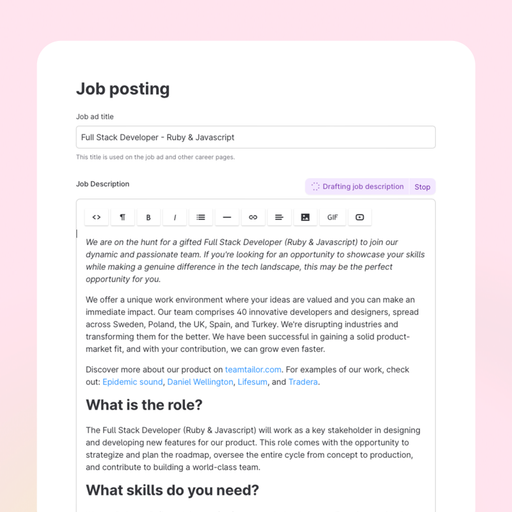
How AI is used in recruitment
In the world of recruitment today, we can see AI being used to automate resume screening, match candidates, and streamline workflows, resulting in greater efficiency and improved decision-making. As we share in another article, one of the significant advantages of AI in recruitment is its potential to eliminate bias and foster diversity. Read how in the article, The Future of Hiring with AI and ChatGPT.
Participants in a study of recruitment professionals were asked where they planned to use AI in their recruitment processes.
55% of respondents said they would use AI for drafting interview questions, 53% said they would summarize CVs, 51% said they would draft emails, 50% said they would draft job descriptions, and 45% said they would summarize interviews/meetings. What's more, 70% of HR professionals believe you can still be personal while using AI.
This reflects the idea that it can serve as a powerful tool for enhancing efficiency and saving time, while not taking anything away from the recruitment process itself.
Using AI to assist with recruitment
Last year, Teamtailor launched the generative AI feature, Co-pilot, which is available in Teamtailor's ATS. Co-pilot uses OpenAI – the same API that ChatGPT is built upon. Co-pilot is made up of several complementary AI tools, each designed to simplify different stages of recruitment. From generating job ads and job descriptions, summarizing resumes, and populating the information into candidate cards to generating correspondence, transcribing candidate video interviews, and creating blog posts, Co-pilot assists recruiters in their processes.
AI will soon become a standard for applicant tracking systems. As we embrace this evolution in both technology and recruitment, we will see increased efficiency, streamlined processes, advanced decision-making, and an opportunity to focus on what makes us human, including creative thinking, emotional intelligence, relationships, and complex problem-solving.
Looking for more inspiration? Watch the webinar on the future of hiring with AI.
Future trends for applicant tracking systems
A number of emerging trends are poised to shape the future of applicant tracking systems. These include:
Even More Use of AI:
Artificial intelligence is here to stay, and its use is only going to grow. AI can assist talent acquisition and hiring teams in streamlining and improving their recruitment. Automating tedious tasks, such as resume screening and candidate matching, makes the hiring process more efficient. According to one source, 67% of HR professionals believe that AI will benefit and have a positive impact on the recruitment process.
Enhanced Candidate Experience:
As AI grows, applicant tracking systems will become candidate-centric. A positive candidate experience attracts top talent and positively impacts the employer brand. Expect to see the use of chatbots for instant communication, mobile-optimized application processes, automated updates, and greater personalization.
Diversity and Inclusion Features:
A growing emphasis on diversity and inclusion calls for unbiased recruitment features in applicant tracking systems. This includes tools for anonymizing resumes, removing unconscious bias, and promoting diverse candidate pools. To learn more about the challenges with biases, DEI, and ED&I, don't miss 'The Diversity Dilemma: True Inclusion or Statistical Illusion?' by Dhevesh Mewawalla Head of UK & International Expansion at Alva Labs.
Integration with Collaboration Tools:
Seamless integration with collaboration tools and communication platforms will also increase. ATS integrations enable hiring teams to communicate, share feedback, and collaborate within the system, and, in turn, streamline the hiring process. According to one report, 88% of HR professionals agree that data-driven collaboration will improve business performance.
Remote Hiring Support:
With remote work becoming more prevalent, ATS will need to accommodate this by providing remote hiring features. This includes a need for virtual interview capabilities, digital onboarding tools, and remote collaboration features.
The future in summary:
Applicant tracking systems have already reshaped modern recruiting and will continue to evolve as candidate and recruiter needs evolve. The future will be defined by the integration of AI, enhanced candidate experiences, data analytics, mobile optimization, and diversity. These trends will help companies become more efficient, attractive and competitive.
FAQs about Applicant Tracking Systems
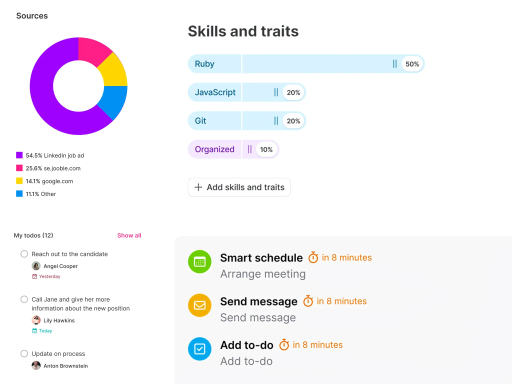
Summary
As we've highlighted and discussed throughout this guide, applicant tracking systems have become essential to modern recruitment. Their scalability and customization allow them to adapt to the evolving needs of HR professionals. After all, talent acquisition is a complex process, and an ATS plays a critical role in shaping organizational efficiency and competitiveness.
A candidate-centric ATS that uses cutting-edge technology, including AI, provides personalized support and continuously adds new features and integrations is essential for navigating the changing workforce landscape.
Here's to your recruitment success!
Want to see how Teamtailor can help you?
Discover the ATS loved by teams and candidates.